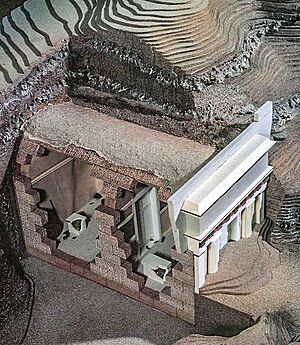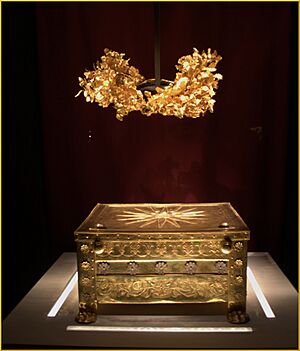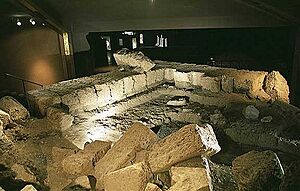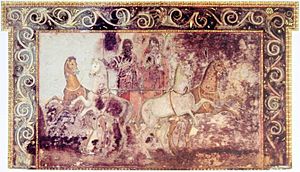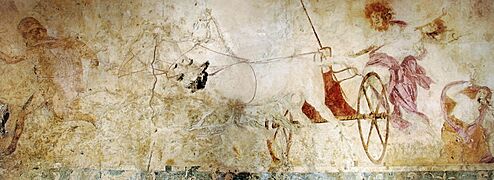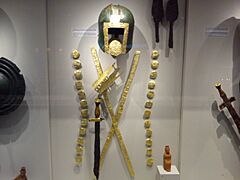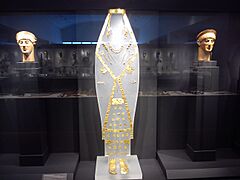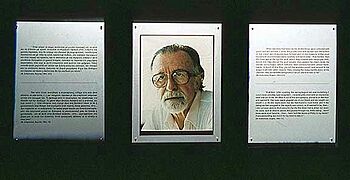Vergina facts for kids
Quick facts for kids
Vergina
Βεργίνα
|
|
|---|---|
| Country | Greece |
| Administrative region | Central Macedonia |
| Regional unit | Imathia |
| Municipality | Veroia |
| • Municipal unit | 69.0 km2 (26.6 sq mi) |
| Lowest elevation | 120 m (390 ft) |
| Population
(2021)
|
|
| • Municipal unit | 2,034 |
| • Municipal unit density | 29.478/km2 (76.35/sq mi) |
| Community | |
| • Population | 1,096 (2021) |
| Time zone | UTC+2 (EET) |
| • Summer (DST) | UTC+3 (EEST) |
| UNESCO World Heritage Site | |
|---|---|
 |
|
| Official name | Archaeological Site of Aigai (modern name Vergina) |
| Criteria | Cultural: i, iii |
| Inscription | 1996 (20th Session) |
| Area | 1,420.81 ha |
| Buffer zone | 4,811.73 ha |
Vergina (Greek: Βεργίνα, Vergína) is a small town in Northern Greece. It is part of the Veria area in Imathia, which is a region of Central Macedonia. Vergina was created in 1922 after a large exchange of people between Greece and Turkey. It used to be its own town until 2011. Then, it joined with Veroia as part of a plan to reorganize local governments.
Vergina is most famous for being the ancient city of Aigai. This was the very first capital city of Macedon, an ancient Greek kingdom. In 336 BC, King Philip II was killed in Aigai's theatre. After his death, his son, Alexander the Great, became king there.
In 1977, archaeologists made an amazing discovery. They found the burial places of several Macedonian kings. One of these was the tomb of Philip II. Unlike many other tombs, it had not been robbed or disturbed. The ancient city also had a huge royal palace. Today, the archaeological museum in Vergina holds all the amazing items found at the site. It is one of the most important museums in Greece.
Aigai is so important that UNESCO has named it a World Heritage Site. It is seen as a special place that shows a big change in European history. This was when ancient city-states started to become large empires.
Contents
Discovering Ancient Aigai: A Journey Through Time
The area around Aigai was home to villages as early as 1000 BC. This has been shown by archaeological digs since 1995. Aigai grew in a similar way to other ancient Greek cities.
Early Kings and the Rise of Macedon
In the 7th century BC, a group called the Temenids became powerful. They led the Macedonians to expand their kingdom. They took control of local groups until the late 6th century BC. This is when the royal family, known as the Argead dynasty, was established in Aigai.
Ancient writers have different stories about how the Argead dynasty began. Alexander I is the first king we know for sure existed. Based on the line of kings, the Macedonian dynasty is thought to have started around 750 BC. The historian Herodotus wrote that the Argead dynasty was an old Greek royal family. He said they were led by Perdiccas I who came from Argos around 650 BC.
The name Aigai means "city of goats." The writer Diodorus Siculus said it was named this way by Perdiccas I. He was told by the Pythian priestess to build his capital where goats led him.
Archaeological finds show that Aigai grew from a group of villages. Its design showed the power of the king and the noble families. Aigai never became a very large city. Most people lived in the villages around it. A walled city center, called an asty or acropolis, was built in the middle of Aigai.
From Aigai, the Macedonians spread into central Macedonia. They moved out the local people called Pierians.
Aigai Under Persian Influence and Growth
From 513 to 480 BC, Aigai was part of the Persian Empire. However, Amyntas I managed to keep some independence. He avoided becoming a full satrapy (a Persian province) and even expanded his lands.
In the first half of the 5th century BC, Aigai became the capital of Macedonia. Life became very luxurious. Merchants from all over the ancient world brought valuable goods to Aigai. These included perfumes, carved decorations, and jewelry. The city wall was built in the 5th century, probably by Perdiccas II.
At the end of the 5th century, King Archelaus I invited famous artists, poets, and thinkers to his court. For example, the famous Greek writer Euripides wrote and performed his last plays in Aigai.
Aigai's Enduring Importance as a Sacred City
In the early 4th century BC, Archelaus moved the capital to Pella. This new city was located on the central Macedonian plain. Even so, Aigai remained very important as the sacred city of the Macedonian kingdom. It was home to traditional religious centers, a royal palace, and the royal tombs.
Because of its importance, King Philip II was in Aigai for his daughter's wedding. His daughter, Cleopatra, was marrying King Alexander of Epirus. It was at this event, in the theatre, that Philip was killed by one of his bodyguards.
Philip's funeral was one of the most grand in Greek history. He was placed on a beautiful gold and ivory bed. He wore a precious golden oak wreath. The king was then honored on a funeral pyre, like a new Hercules.
Decline and Modern Revival
The fierce battles between Alexander's generals in the 3rd century BC harmed Aigai. In 276 BC, Gallic soldiers working for Pyrrhus robbed many of the tombs.
After the Romans defeated the Macedonian kingdom in 168 BC at the Battle of Pydna, both the old and new capitals were destroyed. The walls were torn down, and buildings were burned. In the 1st century AD, a landslide destroyed what had been rebuilt.
From the 2nd to 5th centuries AD, people slowly moved from the hills to the plain. All that was left was a small settlement. Its name, Palatitsia, meaning "palace," was the only hint of its past importance.
The modern town of Vergina was founded in 1922. It was built between two older villages, "Kutlesh" and "Barbes." These villages were once part of the Ottoman Empire. In the 19th century, both Kutlesh and Barbes were Greek villages. People from these villages took part in the Greek uprising of 1821. The town of Vergina was settled by Greek families from Asia Minor. This happened during the population exchange between Greece and Turkey after the Treaty of Lausanne. The name "Vergina" was suggested by a church leader from Veroia. It came from a legendary queen named Vergina (Bergina). She was said to have ruled north of the Haliacmon river and had a summer palace near Palatitsia.
Vergina was its own town from 1922 until 2011. Then, it became part of Veroia. In 2011, the population of Vergina was 2,464 people. Of these, 1,242 lived in Vergina itself.
Unearthing Ancient Secrets: Archaeology in Vergina
Archaeologists became interested in the burial mounds around Vergina in the 1850s. They thought the ancient city of Aigai might be nearby. Digs began in 1861 with French archaeologist Léon Heuzey. He was supported by Napoleon III. Parts of a large building, believed to be a palace, were found near Palatitsa. This building had been partly destroyed by fire. The digs had to stop because of the risk of malaria. Heuzey thought this was the site of an ancient city called Valla, and this idea was believed until 1976.
In 1937, the University of Thessaloniki started digging again. More ruins of the ancient palace were found. But the excavations stopped when war with Italy began in 1940. After the war, the digs continued. In the 1950s and 1960s, the rest of the royal capital was uncovered, including the theatre.
The Royal Tombs: A King's Burial Site
The Greek archaeologist Manolis Andronikos believed that a hill called the Great Tumulus hid the tombs of Macedonian kings. In 1977, Andronikos dug at the Great Tumulus for six weeks. He found four buried tombs. Two of them had never been disturbed. Andronikos said these were the burial places of Macedonian kings. He believed one was the tomb of Philip II, father of Alexander the Great (Tomb II). He also thought another was for Alexander IV of Macedon, son of Alexander the Great (Tomb III).
Some archaeologists disagreed with this idea. But in 2010, new research on the skeletons supported Andronikos's claims. For example, the male skeleton showed a facial injury consistent with what was known about Philip II. In 1987, a group of queens' tombs was found. This included the tomb of Queen Eurydice. In March 2014, five more royal tombs were found in Vergina. They might belong to Alexander I of Macedon and his family, or to the family of Cassander of Macedon. Some items found at Vergina show influences from Achaemenid Persia. This was when Macedon was under Persian control.
Philip II's Royal Burial Cluster
The museum of Philip II's tumulus opened in 1993. It was built over the tombs, leaving them in their original place. This shows the tumulus as it looked before the digs. Inside the museum are four tombs and a small temple called a heroon. This temple was built for Philip II's burial area.
The two most important tombs (II and III) were not robbed. They held the museum's main treasures. Tomb II, belonging to Philip II, was found in 1977. It had two rooms. The main room held a marble chest. Inside was a Golden Larnax made of 24-carat gold, weighing 11 kg. It had the Vergina Sun symbol on it. Inside the golden larnax were the king's bones. There was also a golden wreath with 313 oak leaves and 68 acorns, weighing 717 g.
In the room, archaeologists also found golden and ivory armor. There was a beautifully carved burial bed where the king was placed and later burned. Exquisite silver dishes for the funeral feast were also found. Other amazing items included gold-decorated suits of armor, weapons, and bronze funeral items.
The antechamber had another chest with a golden larnax. This one held the bones of a woman. They were wrapped in a golden-purple cloth with a golden crown decorated with flowers. This shows she was a queen, likely Philip's Thracian wife, Meda. By tradition, she sacrificed herself at the funeral. There was also another burial bed, partly burned. On it was a golden wreath of myrtle leaves and flowers.
Above the Doric order entrance of the tomb is a magnificent wall painting. It is 5.6 meters long and shows a hunting scene. It is believed to be by the famous artist Philoxenos of Eretria. Many think it shows Philip and Alexander.
Next to Philip's tomb, in Tomb I, was a family member, possibly Nicesipolis, another of his queens. She was buried a few years earlier in a stone grave. Sadly, this tomb had been robbed. The only wall painting in this tomb shows the Abduction of Persephone. This is a unique example of ancient painting. It is thought to be by the famous painter Nicomachus of Thebes. It is also one of the few surviving images of ancient beliefs about the afterlife.
In 1978, Tomb III was found near Philip's tomb. It is thought to belong to Alexander IV of Macedon, son of Alexander the Great. He was killed 25 years after Philip. This tomb is a bit smaller than Tomb II and was also not robbed. It had two parts, but only the main room held a cremated body. On a stone stand was a beautiful silver hydria (a type of vase). It held the cremated bones and a golden oak wreath. There were also fine silver items and weapons, showing royal status. A narrow painting of a chariot race decorated the walls. The remains of a wooden burial couch were found. It was decorated with gold and ivory, showing Dionysos with a flute-player and a satyr.
Tomb IV, found in 1980, had an impressive entrance with four Doric columns. It is heavily damaged but may have held valuable treasures. It was built in the 4th century BC and might have belonged to Antigonus II Gonatas.
The Great Tumulus was built in the early 3rd century BC. It was likely built by Antigonos Gonatas over smaller tombs. This was done to protect the royal tombs from being robbed again. The hill material contained many older funeral stones.
The Grand Palace of Aigai
The most important building found is the huge palace. It sits on a flat area just below the acropolis. This building had two or maybe three stories. It was built around a large open courtyard with Doric columns. On the north side was a big gallery. From here, you could see the nearby theatre and the whole Macedonian plain.
The palace was richly decorated. It had mosaic floors, painted walls, and fine relief tiles. The stone and architectural parts were covered with high-quality marble plaster. Digs show it was built during the reign of Philip II. It is thought that the famous architect Pytheos of Priene designed it. He was known for his work on the Mausoleum at Halicarnassus. The theatre, also from the second half of the 4th century BC, was very close to the palace.
Almost 30 large columns that surrounded the palace's main courtyard have been rebuilt. Some stand 25 feet tall. The decorative strip on the south side of the courtyard has also been rebuilt. Over 5,000 square feet of mosaics have been carefully preserved. These mosaics show different scenes, including the story of Europa and nature designs.
The Palace of Aigai is the largest building from classical Greece. It is the place where Alexander the Great was declared king in 336 BC.
The Palace of Aigai reopened to the public in January 2024. This was after a big 16-year restoration project.
Other Important Tombs
The cemetery of the tumuli stretches for over 3 km. It contains more than 500 grave-mounds. Some of these are very rich and date back to the 11th century BC.
To the northwest of the ancient city is an important group of tombs. These date from the 6th and 5th centuries BC. They belonged to members of the Macedonian royal family and their court.
The Cluster of the Queens includes stone and pit tombs. These date to the time of the Greco-Persian Wars. Two of them probably belong to the mother and wife of Alexander I. One is the all-golden "Lady of Aigai." The other is a female relative, whose funeral included at least twenty-six small terracotta statues. One tomb from around 340 BC has an impressive marble throne. It is identified as that of Eurydice, mother of Philip II.
The "Ionic Tomb," also called "Rhomaios's Tomb," is named after its discoverer, Konstantinos Rhomaios. It is an elegant Macedonian tomb with an Ionic style front. It has four columns topped by a painted flower design, which is no longer visible due to weather. It held a marble throne with armrests supported by sphinxes.
Gallery
-
Tomb III, probably belonged to Alexander IV of Macedon
-
Manolis Andronikos in memoriam
See also
- Vergina Sun
- Macedonia (Greece)
- Museum of the Royal Tombs of Aigai (Vergina)



